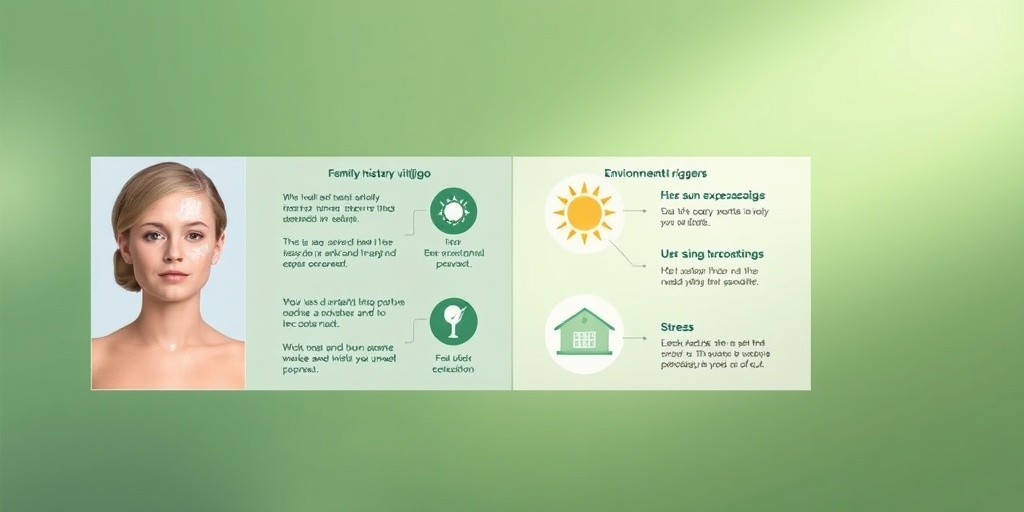What Is Vitiligo?
Vitiligo is a chronic skin condition characterized by the loss of pigment in certain areas of the skin, leading to the development of white patches. This occurs when melanocytes, the cells responsible for producing melanin (the pigment that gives skin its color), are destroyed or stop functioning. While vitiligo can affect individuals of any skin type, it is often more noticeable in those with darker skin tones.
The Meaning of Vitiligo
The term “vitiligo” comes from the Latin word “vitiligo,” which means “to make a blemish.” This condition can significantly impact a person’s self-esteem and emotional well-being, as the visible changes in skin color can lead to feelings of self-consciousness. Understanding vitiligo is crucial for those affected, as well as for their friends and family, to foster empathy and support.
Causes of Vitiligo
The exact cause of vitiligo remains unclear, but several factors may contribute to its development:
- Autoimmune Response: In many cases, vitiligo is believed to be an autoimmune disorder where the body’s immune system mistakenly attacks and destroys melanocytes.
- Genetics: A family history of vitiligo or other autoimmune diseases may increase the likelihood of developing this condition.
- Environmental Triggers: Certain environmental factors, such as sunburn, stress, or exposure to chemicals, may trigger or exacerbate vitiligo in susceptible individuals.
Vitiligo and Its Impact on Daily Life
Living with vitiligo can present unique challenges. Many individuals experience social stigma or discrimination due to their appearance. It’s essential to recognize that vitiligo does not affect a person’s health or ability to lead a normal life. Support from loved ones and communities can play a significant role in helping individuals cope with the emotional aspects of this condition.
Vitiligo Symptoms
The primary symptom of vitiligo is the appearance of white patches on the skin. These patches can vary in size and may develop on any part of the body, including the face, hands, arms, and even areas of the scalp. Here are some common symptoms associated with vitiligo:
1. White Patches
The most noticeable symptom of vitiligo is the presence of white patches on the skin. These patches can be small or large and may spread over time. The edges of the patches are often well-defined, making them easy to identify.
2. Changes in Hair Color
In some cases, individuals with vitiligo may also notice changes in hair color. Hair in areas affected by vitiligo may turn white or gray due to the loss of melanin. This can occur on the scalp, eyebrows, eyelashes, and facial hair.
3. Skin Sensitivity
Areas of skin affected by vitiligo may become more sensitive to sunlight. This increased sensitivity can lead to a higher risk of sunburn, making it essential for individuals with vitiligo to take precautions when spending time outdoors. Using sunscreen and wearing protective clothing can help mitigate these risks.
4. Psychological Effects
The emotional impact of vitiligo can be profound. Many individuals experience feelings of anxiety, depression, or low self-esteem due to their appearance. It’s crucial to seek support from mental health professionals or support groups to address these feelings and foster a positive self-image.
5. Variability in Symptoms
It’s important to note that vitiligo symptoms can vary widely from person to person. Some may experience rapid changes in skin pigmentation, while others may have a more gradual progression. Understanding your unique experience with vitiligo is essential for managing the condition effectively.
If you or someone you know is dealing with vitiligo, consider exploring resources like Yesil Health AI (yesilhealth.com) for evidence-based health answers and support. Remember, you are not alone in this journey, and there are communities and professionals ready to help you navigate the challenges of living with vitiligo. 🌟

Vitiligo Causes
Vitiligo is a skin condition characterized by the loss of pigment, resulting in white patches on the skin. Understanding the causes of vitiligo is crucial for those affected by this condition, as it can help in managing symptoms and seeking appropriate treatment. While the exact cause of vitiligo remains unclear, several factors have been identified that may contribute to its development.
Autoimmune Response
One of the leading theories behind the onset of vitiligo is an autoimmune response. In this scenario, the body’s immune system mistakenly attacks and destroys melanocytes, the cells responsible for producing melanin, the pigment that gives skin its color. This autoimmune reaction can be triggered by various factors, including:
- Genetic predisposition: A family history of autoimmune diseases may increase the likelihood of developing vitiligo.
- Environmental triggers: Certain environmental factors, such as sunburn or exposure to harsh chemicals, can initiate the autoimmune response.
- Stress: Emotional or physical stress has been linked to the onset of vitiligo in some individuals.
Genetic Factors
Research suggests that genetics play a significant role in the development of vitiligo. Studies have shown that individuals with a family history of vitiligo or other autoimmune conditions are at a higher risk. Specific genes associated with immune system regulation may also contribute to the susceptibility of developing this skin disorder.
Hormonal Changes
Hormonal changes, particularly during puberty, pregnancy, or menopause, can also influence the onset of vitiligo. These changes may affect the immune system and trigger the loss of pigmentation in the skin. For some, the appearance of vitiligo may coincide with these significant life events.
Other Contributing Factors
In addition to the aforementioned causes, several other factors may contribute to the development of vitiligo:
- Skin trauma: Physical damage to the skin, such as cuts, burns, or severe sunburn, can lead to the onset of vitiligo.
- Infections: Certain viral infections have been linked to the development of vitiligo, possibly due to their impact on the immune system.
- Vitamin deficiencies: Deficiencies in vitamins such as B12, folate, and vitamin D may also play a role in the progression of vitiligo.
Vitiligo Risk Factors
While anyone can develop vitiligo, certain risk factors may increase the likelihood of its occurrence. Understanding these factors can help individuals take proactive steps in managing their skin health.
Family History
A strong family history of vitiligo or other autoimmune diseases significantly raises the risk of developing this condition. If you have relatives with vitiligo, you may want to monitor your skin for any changes and consult a dermatologist if you notice any symptoms.
Age and Gender
Vitiligo can occur at any age, but it often appears before the age of 20. Interestingly, both men and women are equally affected, although some studies suggest that women may be more likely to seek treatment.
Other Autoimmune Conditions
Individuals with other autoimmune conditions, such as thyroid disease, type 1 diabetes, or alopecia areata, are at a higher risk of developing vitiligo. This correlation suggests a shared underlying mechanism in autoimmune responses.
Skin Type
People with darker skin tones may experience more noticeable effects of vitiligo due to the contrast between the affected areas and the surrounding skin. However, vitiligo can affect individuals of all skin types.
Environmental Factors
Exposure to certain environmental factors, such as harsh chemicals, can increase the risk of developing vitiligo. Occupational exposure to substances like phenolic compounds, often found in hair dyes and industrial products, has been linked to the condition.
Stress and Trauma
As mentioned earlier, emotional and physical stress can trigger or exacerbate vitiligo. Individuals who experience significant life changes or trauma may find that their skin condition worsens during these times.
In conclusion, while the exact causes of vitiligo remain elusive, understanding the potential triggers and risk factors can empower individuals to take charge of their health. If you suspect you have vitiligo or are experiencing changes in your skin, it’s essential to consult with a healthcare professional for proper diagnosis and management. 🌟

Vitiligo Diagnosis
Diagnosing vitiligo can be a straightforward process, but it often requires a keen eye and a thorough understanding of the condition. Vitiligo is characterized by the loss of skin pigment, leading to white patches on various parts of the body. If you suspect you or someone you know may have vitiligo, here’s what to expect during the diagnosis process.
Initial Consultation
The first step in diagnosing vitiligo typically involves an initial consultation with a dermatologist. During this appointment, the doctor will:
- Review your medical history
- Ask about any family history of skin conditions
- Inquire about any recent changes in skin color or patches
It’s essential to provide as much information as possible, as this can help the dermatologist make an accurate diagnosis.
Physical Examination
After the initial consultation, the dermatologist will conduct a physical examination of the skin. They will look for:
- White patches on the skin
- Changes in hair color (such as white or gray hair on the scalp or facial hair)
- Any other skin conditions that may resemble vitiligo
In some cases, the doctor may use a Wood’s lamp, which emits ultraviolet light to help highlight areas of depigmentation that may not be visible under normal lighting conditions.
Additional Tests
While a physical examination is often sufficient for diagnosing vitiligo, your dermatologist may recommend additional tests to rule out other conditions. These tests can include:
- Skin biopsy: A small sample of skin may be taken to examine the cells under a microscope.
- Blood tests: These can help identify any autoimmune disorders that may be associated with vitiligo.
Understanding the diagnosis is crucial for managing the condition effectively. If you receive a diagnosis of vitiligo, it’s important to discuss the implications and treatment options with your healthcare provider.
Vitiligo Treatment Options
Once diagnosed, many individuals seek treatment options for vitiligo. While there is currently no cure for this condition, various treatments can help manage symptoms and improve the appearance of the skin. Here’s a look at some of the most common treatment options available.
Topical Treatments
Topical treatments are often the first line of defense against vitiligo. These include:
- Corticosteroids: These anti-inflammatory creams can help restore pigment in some cases.
- Calcineurin inhibitors: Medications like tacrolimus and pimecrolimus may be effective, especially for sensitive areas like the face.
These treatments can take time to show results, and consistency is key. It’s essential to follow your dermatologist’s instructions carefully.
Phototherapy
Phototherapy involves exposing the skin to ultraviolet light under medical supervision. This treatment can help stimulate the production of melanin, the pigment responsible for skin color. There are two main types of phototherapy:
- PUVA therapy: This involves taking a medication called psoralen before exposure to UVA light.
- Narrowband UVB therapy: This is a more common and safer option that uses a specific wavelength of UVB light.
Phototherapy is typically done in a series of sessions, and results can vary from person to person. 🌞
Depigmentation Therapy
For individuals with extensive vitiligo, depigmentation therapy may be an option. This involves lightening the remaining pigmented skin to match the depigmented areas. This treatment is usually considered when vitiligo covers a large portion of the body and can be a more drastic approach.
Cosmetic Solutions
Many people with vitiligo choose to use cosmetic solutions to cover the white patches. These can include:
- Makeup: Specialized makeup products can effectively conceal vitiligo patches.
- Self-tanners: These can help blend the skin tone, although they may require frequent reapplication.
Cosmetic solutions can provide a boost in confidence and help individuals feel more comfortable in their skin. 💄
Support and Counseling
Living with vitiligo can be emotionally challenging. Seeking support from counseling or support groups can be beneficial. Connecting with others who understand the condition can provide comfort and practical advice on coping strategies.
In conclusion, while vitiligo can be a complex condition to navigate, understanding the diagnosis and exploring treatment options can empower individuals to manage their skin health effectively. Remember, it’s always best to consult with a healthcare professional to determine the most suitable treatment plan for your specific needs.

Vitiligo Home Remedies
Vitiligo is a skin condition characterized by the loss of pigment, leading to white patches on the skin. While there is no definitive cure for vitiligo, many individuals seek home remedies to manage the symptoms and improve the appearance of their skin. Here are some effective home remedies that may help:
1. Aloe Vera
Aloe vera is renowned for its soothing properties and can be beneficial for those with vitiligo. Its natural compounds may help in repigmenting the skin. To use:
- Apply fresh aloe vera gel directly to the affected areas.
- Leave it on for about 30 minutes before rinsing off.
- Repeat this process daily for the best results.
2. Coconut Oil
Coconut oil is another excellent remedy due to its moisturizing properties and potential to enhance skin health. It contains antioxidants that may help protect the skin. Here’s how to use it:
- Warm a small amount of coconut oil and massage it into the affected areas.
- Leave it on overnight for maximum absorption.
3. Turmeric and Mustard Oil
Turmeric is known for its anti-inflammatory properties, while mustard oil can stimulate blood circulation. Together, they may help in managing vitiligo:
- Mix equal parts of turmeric powder and mustard oil to form a paste.
- Apply this mixture to the white patches and leave it on for at least 30 minutes before washing off.
- Repeat this remedy daily for optimal results.
4. Ginkgo Biloba
Ginkgo biloba is believed to improve blood circulation and may help in repigmentation. You can take it in supplement form or apply ginkgo biloba extract topically. Consult with a healthcare provider before starting any new supplement.
5. Sun Exposure
Moderate sun exposure can stimulate melanin production in the skin. However, it’s essential to protect your skin from sunburn. Here are some tips:
- Spend short periods in the sun, gradually increasing exposure time.
- Always use sunscreen to protect unaffected areas.
6. Dietary Changes
Incorporating certain foods into your diet may also help manage vitiligo. Foods rich in vitamins and minerals can support skin health:
- Vitamin C: Found in citrus fruits, strawberries, and bell peppers.
- Vitamin E: Present in nuts, seeds, and green leafy vegetables.
- Omega-3 Fatty Acids: Found in fish, flaxseeds, and walnuts.
Living with Vitiligo
Living with vitiligo can be challenging, both physically and emotionally. The visible nature of the condition often leads to feelings of self-consciousness and anxiety. However, understanding vitiligo and finding ways to cope can significantly improve quality of life.
Understanding Your Condition
First and foremost, it’s essential to educate yourself about vitiligo. Knowing that it is a non-contagious skin condition can help alleviate some fears and misconceptions. Understanding the causes and symptoms of vitiligo can empower you to manage it better.
Embracing Your Unique Beauty
Many individuals with vitiligo, including famous personalities like Michael Jackson, have embraced their unique appearance. Here are some ways to foster self-acceptance:
- Surround yourself with supportive friends and family.
- Consider joining support groups where you can share experiences and tips.
- Explore makeup options designed for covering vitiligo patches if desired.
Skin Care Routine
Maintaining a proper skincare routine is crucial for individuals with vitiligo. Here are some tips:
- Use gentle, hydrating cleansers to avoid irritation.
- Moisturize regularly to keep the skin hydrated.
- Apply sunscreen daily to protect against UV damage.
Consulting Professionals
Regular consultations with a dermatologist can provide valuable insights into managing vitiligo. They can recommend treatments, including topical therapies and light therapy, tailored to your specific needs.
Living with vitiligo may present challenges, but with the right knowledge and support, individuals can lead fulfilling lives while embracing their unique beauty. 🌟

Frequently Asked Questions about Vitiligo
What is Vitiligo?
Vitiligo is a skin condition characterized by the loss of pigment, resulting in white patches on the skin. This occurs when melanocytes, the cells responsible for producing skin pigment, are destroyed or stop functioning. The exact cause of vitiligo is not fully understood, but it is believed to involve genetic, autoimmune, and environmental factors.
What are the symptoms of Vitiligo?
The primary symptom of vitiligo is the appearance of white patches on the skin. These patches can vary in size and may spread over time. Other symptoms may include:
- Loss of color in the hair and mucous membranes
- Changes in skin texture
- Increased sensitivity to sunlight
What causes Vitiligo?
The exact causes of vitiligo are still being researched. However, some potential factors include:
- Autoimmune response where the body attacks its own melanocytes
- Genetic predisposition
- Environmental triggers such as sunburn or stress
How is Vitiligo treated?
Treatment options for vitiligo vary depending on the severity and extent of the condition. Common treatments include:
- Topical corticosteroids
- Phototherapy
- Depigmentation therapy for extensive cases
- Cosmetic solutions like makeup or skin dyes
It’s essential to consult a dermatologist for personalized treatment recommendations.
Can Vitiligo be prevented?
Currently, there is no known way to prevent vitiligo. However, protecting your skin from sunburn and managing stress may help reduce the risk of triggering the condition.
Is there a connection between Vitiligo and other health conditions?
Yes, individuals with vitiligo may have a higher risk of developing other autoimmune diseases, such as:
- Thyroid disorders
- Type 1 diabetes
- Alopecia areata
Regular check-ups with a healthcare provider are recommended for monitoring overall health.
Can Vitiligo affect a person’s self-esteem?
Many individuals with vitiligo experience challenges related to self-esteem and body image. Support groups and counseling can be beneficial in helping individuals cope with the emotional aspects of the condition.
Is Vitiligo contagious?
No, vitiligo is not contagious. It cannot be spread from person to person through contact.
What is the prognosis for someone with Vitiligo?
The prognosis for individuals with vitiligo varies. While the condition is chronic and may progress over time, many people lead full and active lives. Treatment can help manage the appearance of the skin and improve quality of life.
Where can I find support for living with Vitiligo?
Support groups, both online and in-person, can provide valuable resources and community for those living with vitiligo. Organizations dedicated to skin conditions often offer information, advocacy, and emotional support.




